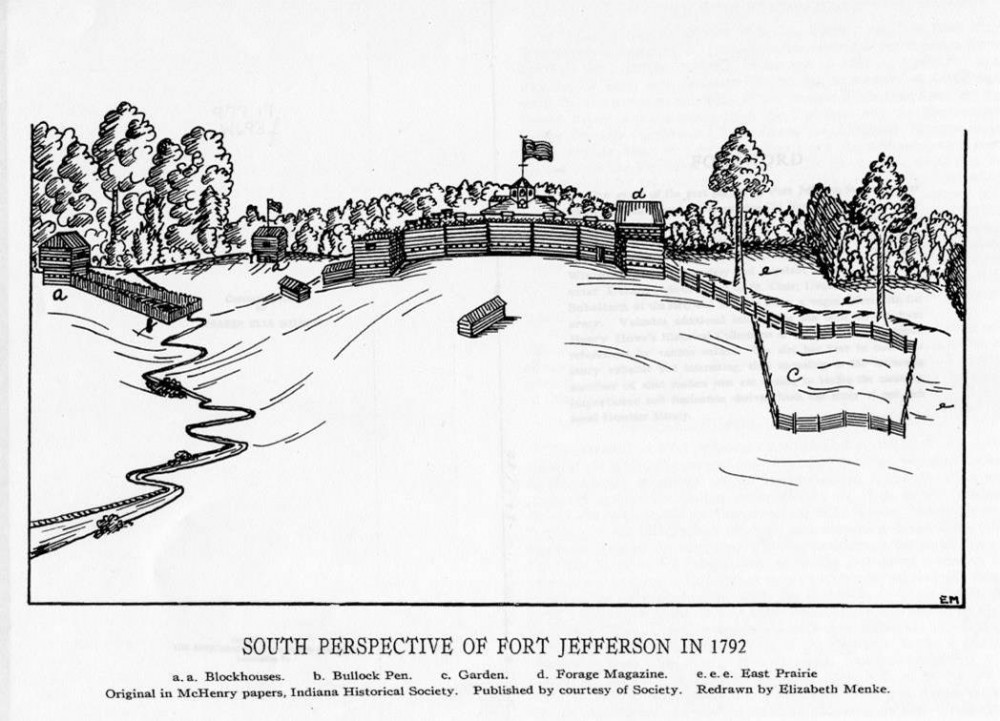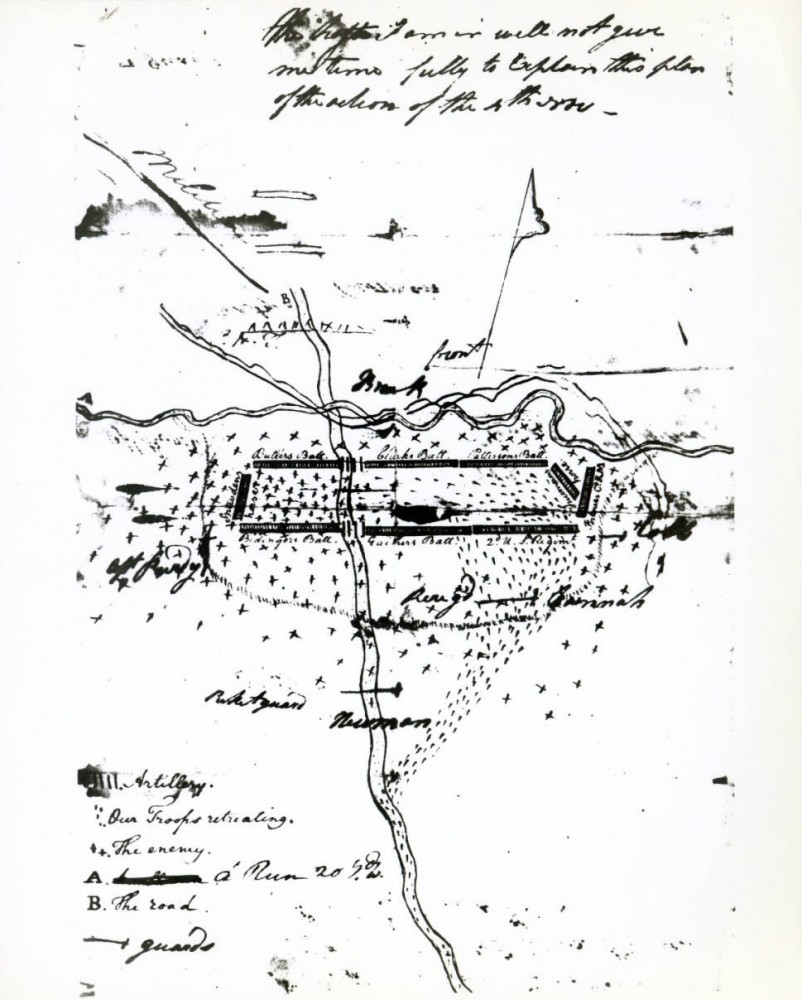The rediscovery of the the documentation related to the archaeological exploration of Fort Jefferson in 1930 has brought renewed and long overdue attention to this important episode in Ohio’s and America’s history. In the following guest blog, OHS Curator of Manuscripts John Haas puts this new material into its historic context.

Image of Fort Jefferson was redrawn by Elizabeth Menke from the original in the McHenry Papers, at Indiana Historical Society. Published by courtesy of the Society, in Fort Jefferson, by Frazer Ells Wilson, 1950 copyright. An image of the original drawing appears in The Mapping of Ohio, by Thomas H. Smith, page 87. OHS also has a copy of the image in SC 283.
Fort Jefferson is located in the town of Fort Jefferson Darke County Ohio and was at the time the northern most outpost of the U. S. Army in western Ohio. It was constructed in October 1791 by the military force commanded by former Revolutionary War General Arthur St. Clair and in 1791 Governor of the North West Territory. Governor St. Clair was on a campaign to subdue the American Indian tribes that had been raiding American settlements as far south as the Ohio River. This 1791 operation was the second major military campaign of the North West Indian War; the first being General Josiah Harmar’s campaign in 1790 against the American Indian villages around what is now Fort Wayne Indiana.
According to Frazer Ells Wilson the main object of the projected campaign was the establishment of a strong military post at the forks of the Maumee, the cutting of a new and shorter road from his base (Fort Washington-Cincinnati) through the unexplored wilderness, and the erection of a chain of log forts at convenient distances for strengthening and holding the line. St. Clair originally left Fort Washington (Cincinnati) in early September and built Fort Hamilton on the banks of the Great Miami River between September 11 and October 2, 1791. General Richard Butler left Fort Hamilton, now the town of Hamilton in Butler County, on October 4, 1791 and covered the 44 miles to the Fort Jefferson site in 10 days marching. St. Clair had gone back to Fort Washington to gather more troops and rejoined the small army on October 8, 1791.
How large was this small army that General Arthur St. Clair led up from Fort Washington? Originally it consisted of two small regular army regiments (600), two regiments of six-month conscripts (800) and 600 militia, about two thousand at its peak, plus an estimated 400 camp followers. Garrisons had to be left behind at Fort Washington, Fort Hamilton and Fort Jefferson, over 200 of the camp followers returned to Fort Washington, many of the militia and conscripts deserted along the way so about 1400 people reached Fort Jefferson. The site of Fort Jefferson was reached by St. Clairs troops on or about October 13, 1791. Fort Jefferson was completed by October 23, 1791 and named after then Secretary of State Thomas Jefferson. St. Clairs army left the next day on its march northward to find the villages of the American Indian Confederacy along the Maumee River. The building at Fort Jefferson did not end at this point; further construction of at least two additional block houses were added, a corral, several out buildings, a walled garden and other structures and tunnels to a fresh water spring and a powder magazine. By November 2, 1791 St. Clair had around 1,120 in his advanced command, including camp followers. On November 3, 1791 there were 920 officers and men present for duty.

Copy of a hand-drawn military map shows the encampment and disposition of forces during the Battle of the Wabash on Nov. 4, 1791, near the future Fort Recovery, Ohio. The sketch shows the battle lines and location of battalions, artillery, the Native Americans, and line of retreat.
November the 4th, 1791 St. Clair’s army was attacked by the American Indian Confederacy of about 1000 warriors led by Little Turtle of the Miami tribe, Blue Jacket of the Shawnee and Buckongahelas of the Delaware (Lenape) tribe. There were also a large number of Potawatomis from Eastern Michigan and the Saint Joseph. This post is about Fort Jefferson and not a description or reassessment of the battle known as St. Clair’s Defeat but suffice it to say it is known as the single greatest defeat suffered by a United States military force and conversely one of the most one sided victories of a American Indian confederacy over said United States Army. The estimates of St. Clair’s losses are about 950 soldiers and civilians of which 680 were killed. The survivors fled the battlefield and reached Fort Jefferson within a day. American Indian losses are estimated to be about 80 warriors killed and wounded. The wounded too badly hurt to continue were left at Fort Jefferson with the garrison and the remainder of the army continued its retreat back to Fort Hamilton and on to Fort Washington. It is known that many of the wounded left at Fort Jefferson died of their wounds, due to severity in some cases and lack of adequate medical care and medicine. Fort Jefferson was not attacked by the American Indian Confederacy following the rout of St. Clair’s army. They pursued the survivors for a few hours and then returned to the site of the battle, gathered up horses and equipment and returned north back to the villages along the Maumee. However over the succeeding years Fort Jefferson was hit with raids which caused the deaths of at least another 20 or so officers and soldiers.
After General Arthur St. Clair was relieved of command the western army was led by General James Wilkinson who turned out to be a plotter, schemer, traitor and spy. But he also liked his comforts and had impressive living accommodations built at both Fort Hamilton and Fort Jefferson and these homes hosted lavish dinners and entertainments. One positive accomplishment of General Wilkinson was the building of Fort St. Clair. He ordered Major John Gano to build a post half way between Fort Jefferson and Fort Hamilton to make the line of posts closer together and easier to supply and protect. Fort St. Clair is near what is now Eaton in Preble County. Wilkinson in turn was replaced by General Anthony Mad Anthony Wayne, who led the next major U.S. military campaign of the North West Indian War. After gathering and assembling the new United States Western army, the Legion of the United States, Wayne set out from Fort Washington in the fall of 1793 and traveled the route through Fort Hamilton, Fort St. Clair and on to Fort Jefferson and reached in early October 1793. He used Fort Jefferson as a base of supply and rest and then moved six miles further north and built Fort Greenville. In December 1793 Wayne sent several companies of infantry to the site of the battlefield of St. Clairs Defeat and had them build a fort on that site, Fort Recovery. Wayne spent the rest of the winter strengthening his positions at Forts Jefferson, Greenville and Recovery in preparation for the spring campaign.
In late June of 1794 the American Indian Confederacy gathered 1500 Shawnee, Delaware, Ottawa, Miami and Ojibwa warriors under the command of Little Turtle, Blue Jacket and Simon Girty with the object of forcing Wayne to abandon Forts Recovery and Greenville and roll back the American army presence in their territory. Several attacks were launched against supply columns and eventually a direct attack on Fort Recovery. It was repulsed and the American Indian troops withdrew further north. General Wayne launched his campaign in July 1794 and it resulted in the Battle of Fallen Timbers, August 20, 1794, which was a clear cut American Army victory over the American Indian Confederacy. The victory of Fallen Timbers, after some fits and starts, led to the gathering of the tribes at Fort Greenville from January to August of 1795 to settle the war and negotiate a peace treaty. This gathering contained hundreds of American soldiers and civilians, and over 1000 American Indians from numerous tribes. Fort Jefferson remained in use and was still useful as a supply post until the Treaty of Greenville was ratified. By the summer of 1796 the usefulness of Fort Jefferson was at an end and the U.S. Army abandoned the post and burned it. But a village grew up near the old post and was named Fort Jefferson and still flourishes today. In 1907 a memorial was erected at the site by the Greenville Historical Society. In 1929 the Ohio Historical Society purchased the site for the state of Ohio. In 1930 an archaeological expedition from the Ohio Historical Society discovered two tunnels on the site. One led to an underground powder magazine and the other to a spring. Further explorations were done on the site but these activities are explained in detail by Mr. Bill Pickard in another blog on this site.
Sources
Fort Jefferson: the Frontier post of the Upper Miami Valley. Frazer Ells Wilson, the Intelligencer Printing Company, Lancaster, PA., 1950 The Forts of Ohio: A guide to military stockades. Gary S. Williams. Buckeye Book Press, Caldwell, Ohio, 2003 The Mapping of Ohio, Thomas H. Smith, Kent State University Press, 1977 Ohio History, Vol. 17, 1908, Monument at Fort Jefferson, pages 112-131. Ohio History, Vol. 38, 1929, A Visit in 1929 to the sites in western Ohio, of forts built by Generals Arthur St. Clair, Anthony Wayne and William Henry Harrison, by James A. Green, pages 601-625. Ohio Historical Society collections: SC 283 Fort Jefferson SC 1136 St. Clair’s Defeat OVS 7212 Arthur St. Clair 1791, Orders of March, Battle and Encampment Ohio Memory Ohio Pix Ohio History Central OHS Museums & Historic Sites John Haas